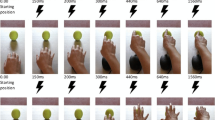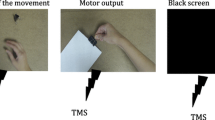Abstract
Motor resonance is typically considered a modulation of motor activity during action observation, which mirrors the pattern of muscle activation occurring during execution of the observed action. There is preliminary evidence that motor activity accompanying action observation comprises two stages: an initial non-specific modulation, followed by a later change in excitability that is specific to the muscles involved in the action. We built on this previous work, with the aims of (1) clarifying the time-course of muscle specificity during action observation and (2) establishing whether modulation at each time point reflects significant changes (facilitation or suppression) from baseline. Motor-evoked potentials were elicited in two muscles—the first dorsal interosseous (FDI) and abductor digiti minimi (ADM)—while participants watched stimuli showing index or little finger abduction. Our results provide partial support for previous findings of muscle-specific modulation after, but not before, 200 ms. Interestingly, however, this was shown only by facilitation of the FDI during index finger observation; there was no significant facilitation of the ADM when little finger movement was observed. Furthermore, we found no facilitation of corticospinal excitability (specific or non-specific) at time points earlier than 200 ms (100–150 ms). We discuss these results in the context of previous work showing a non-specific increase in excitability at 90 ms during action observation. Together, these findings suggest a fast and short-lived facilitation of corticospinal excitability that occurs at around 60–90 ms and ends by 100–150 ms.


Similar content being viewed by others
Notes
Further details about the shape condition, as well as the data from this and the other conditions, can be obtained from the corresponding author if required.
Because the RMT was based on the intensity of TMS needed to evoke responses in both the ADM and the FDI, it actually reflected the lowest intensity required to elicit MEPs in the least excitable muscle. Thus, in some cases, the stimulation intensity would have reflected different percentages of the RMT for each muscle (i.e., what we consider to be ‘115 % of the RMT’ might in fact have reflected 120 % of the RMT for the muscle with the lowest threshold). The implications of this are mentioned briefly in the “Discussion” section.
References
Candidi M, Sacheli LM, Mega I, Aglioti SM (2014) Somatotopic mapping of piano fingering errors in sensorimotor experts: TMS studies in pianists and visually trained musical naïves. Cereb Cortex 24:435–443
Cavallo A, Heyes C, Becchio C, Bird G, Catmur C (2013) Timecourse of mirror and counter-mirror effects measured with transcranial magnetic stimulation. Soc Cogn Affect Neurosci. doi:10.1093/scan/nst085
Cross ES, Hamilton AFC, Grafton ST (2006) Building a motor simulation de novo: observation of dance by dancers. NeuroImage 31(1):1257–1267
Fadiga L, Fogassi L, Pavesi G, Rizzolatti G (1995) Motor facilitation during action observation: a magnetic stimulation study. J Neurophysiol 73(6):2608–2611
Häger-Ross C, Schieber MH (2000) Quantifying the independence of human finger movements: comparisons of digits, hands, and movement frequencies. J Neurosci 20(22):8542–8550
Iacoboni M, Woods RP, Brass M, Bekkering H, Mazziotta JC, Rizzolatti G (1999) Cortical mechanisms of human imitation. Science 286(5449):2526–2528
Jola C, Abedian-Amiri A, Kuppuswamy A, Pollick FE, Grosbras M (2012) Motor simulation without motor expertise: enhanced corticospinal excitability in visually experienced dance spectators. PLoS One. doi:10.1371/journal.pone.0033343
Kaneko F, Yasojima T, Kizuka T (2007) Kinesthetic illusory feeling induced by a finger movement movie effects on corticomotor excitability. Neuroscience 149:976–984
Lepage JF, Tremblay S, Theoret H (2010) Early non-specific modulation of corticospinal excitability during action observation. Eur J Neurosci 31(5):931–937
Loporto M, Holmes PS, Wright DJ, McAllister CJ (2013) Reflecting on mirror mechanisms: Motor resonance effects during action observation only present with low-intensity transcranial magnetic stimulation. PLoS ONE 8(5):e64911. doi:10.1371/journal.pone.0064911
Makin TR, Holmes NP, Brozzoli C, Rossetti Y, Farnè A (2009) Coding of visual space during motor preparation: approaching objects rapidly modulate corticospinal excitability in hand-centred coordinates. J Neurosci 29(38):11841–11851
Naish KR, Houston-Price C, Bremner AJ, Holmes NP (2014) Effects of action observation on corticospinal excitability: muscle specificity, direction, and timing of the mirror response. Neuropsychologia 64:331–348
Rizzolatti G, Craighero L (2004) The mirror-neuron system. Annu Rev Neurosci 27:169–192
Romani M, Cesari P, Urgesi C, Facchini S, Aglioti SM (2005) Motor facilitation of the human cortico-spinal system during observation of bio-mechanically impossible movements. Neuroimage 26:755–763
Roy AC, Craighero L, Fabbri-Destro M, Fadiga L (2008) Phonological and lexical motor facilitation during speech listening: a transcranial magnetic stimulation study. J Physiol (Paris) 102(1–3):101–105
van Schie HT, Koelewijn T, Jensen O, Oostenveld R, Maris E, Bekkering H (2008) Evidence for fast, low-level motor resonance to action observation: an MEG study. Soc Neurosci 3(3–4):213–228
Acknowledgments
This work was supported by a SSHRC grant awarded to SSO. We thank Dr Caroline Catmur for her permission to use the stimuli used in Cavallo et al. (2013), and Megan Grocholsky for her help with data collection.
Author information
Authors and Affiliations
Corresponding author
Electronic supplementary material
Below is the link to the electronic supplementary material.
Rights and permissions
About this article
Cite this article
Naish, K.R., Obhi, S.S. Timing and specificity of early changes in motor excitability during movement observation. Exp Brain Res 233, 1867–1874 (2015). https://doi.org/10.1007/s00221-015-4258-0
Received:
Accepted:
Published:
Issue Date:
DOI: https://doi.org/10.1007/s00221-015-4258-0




